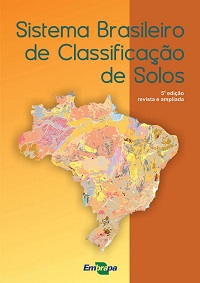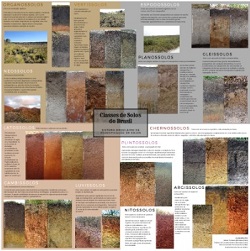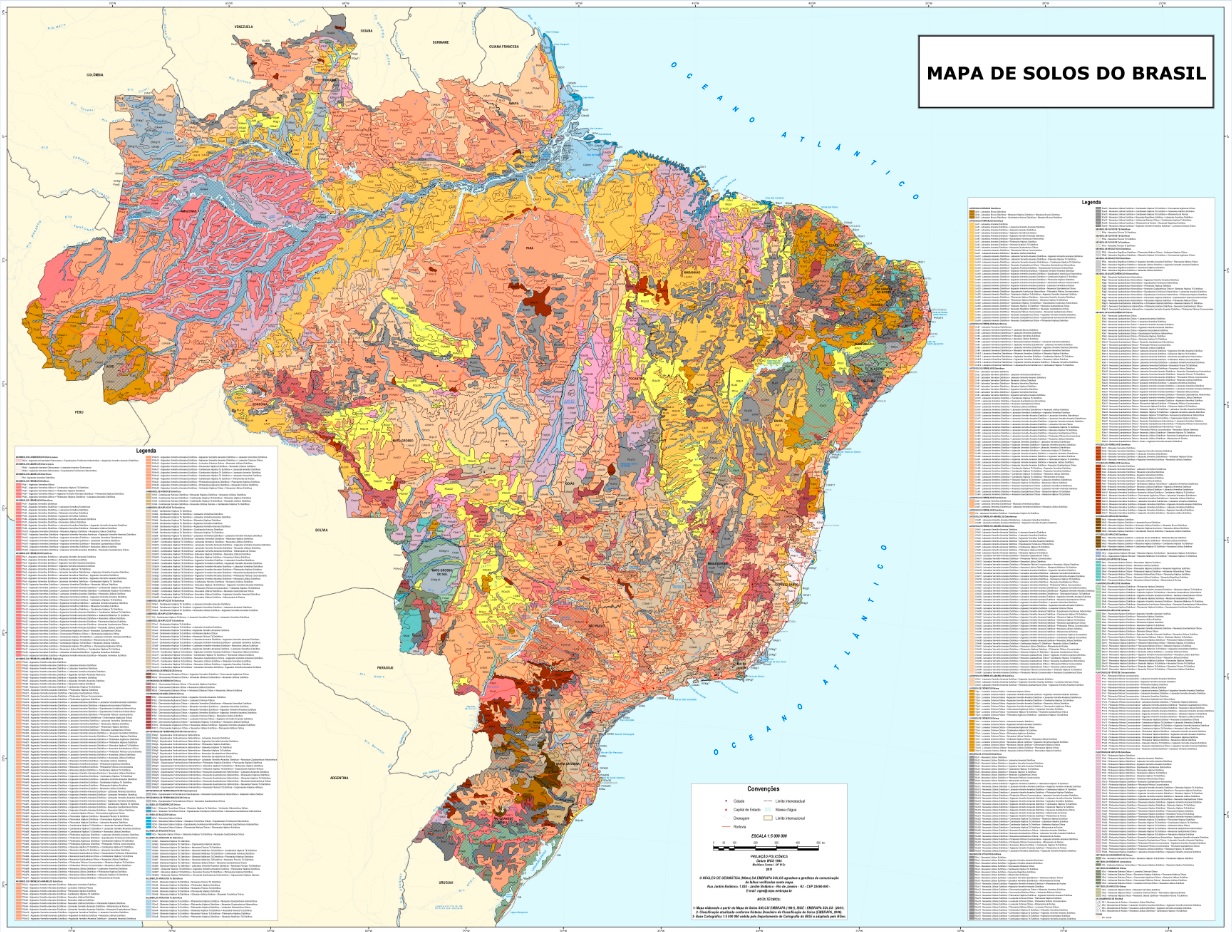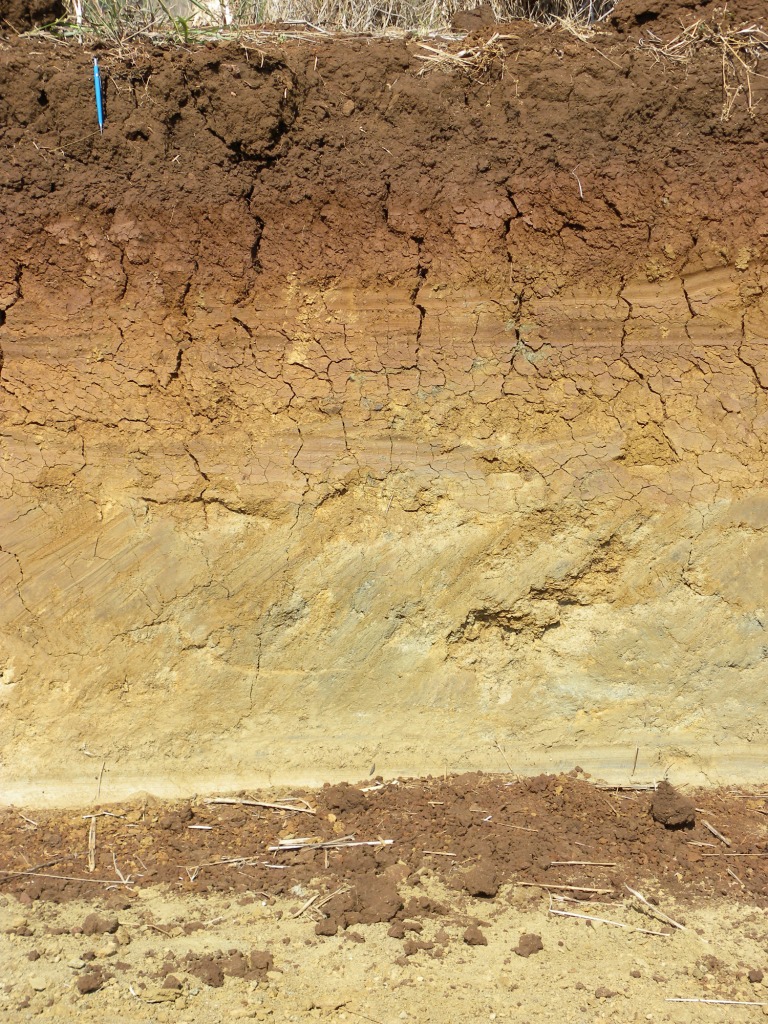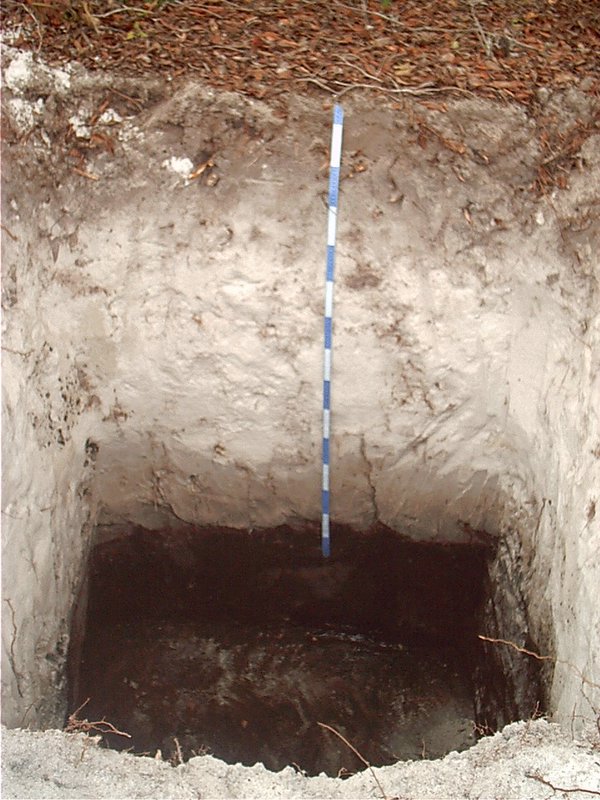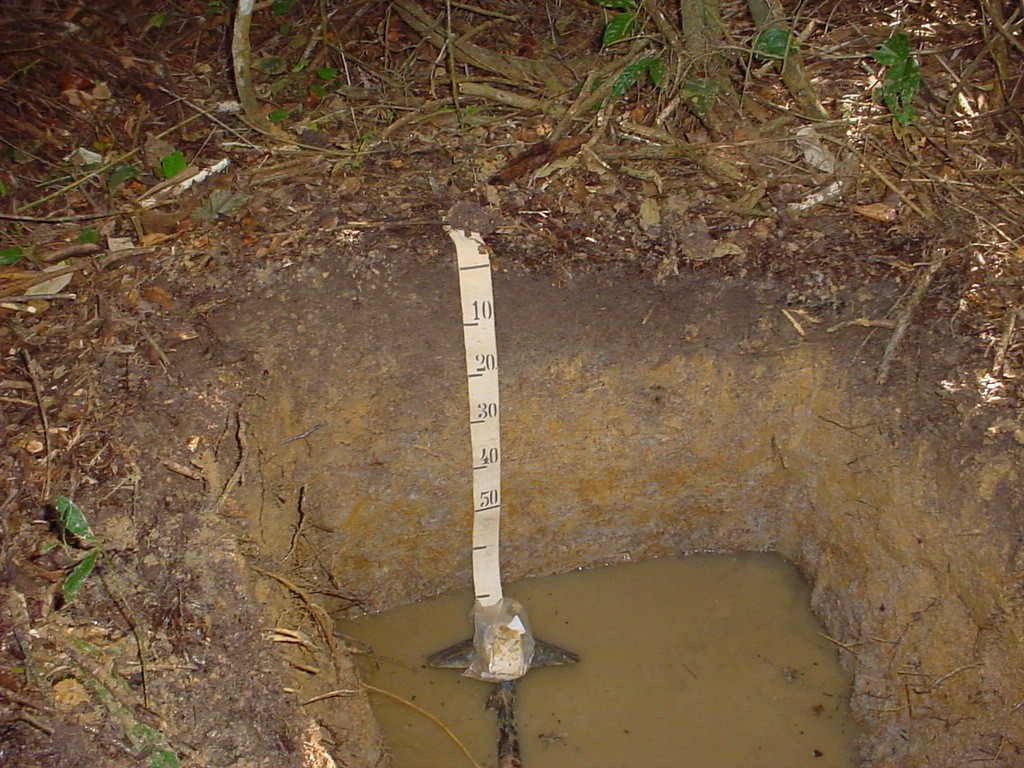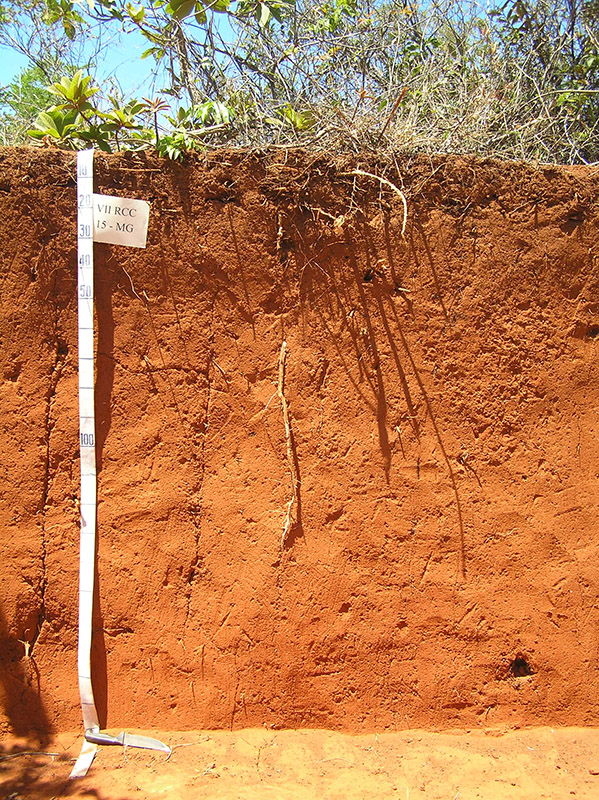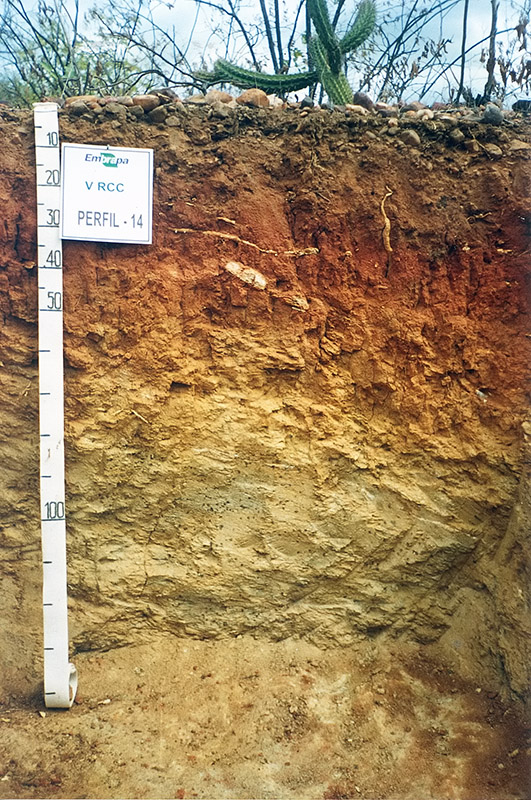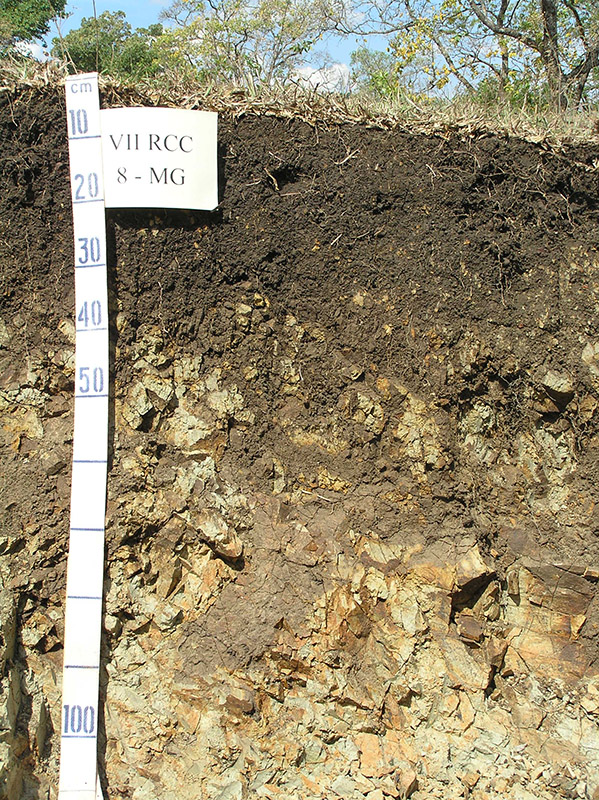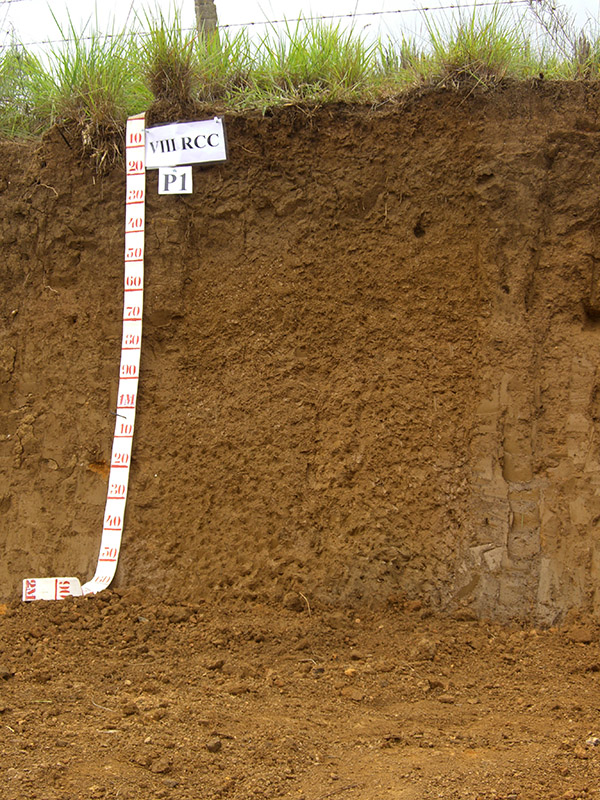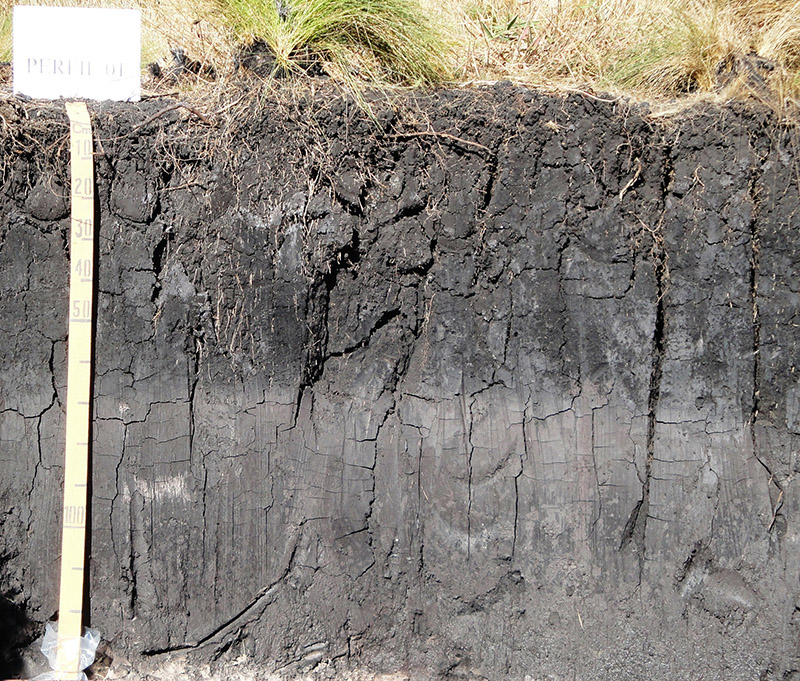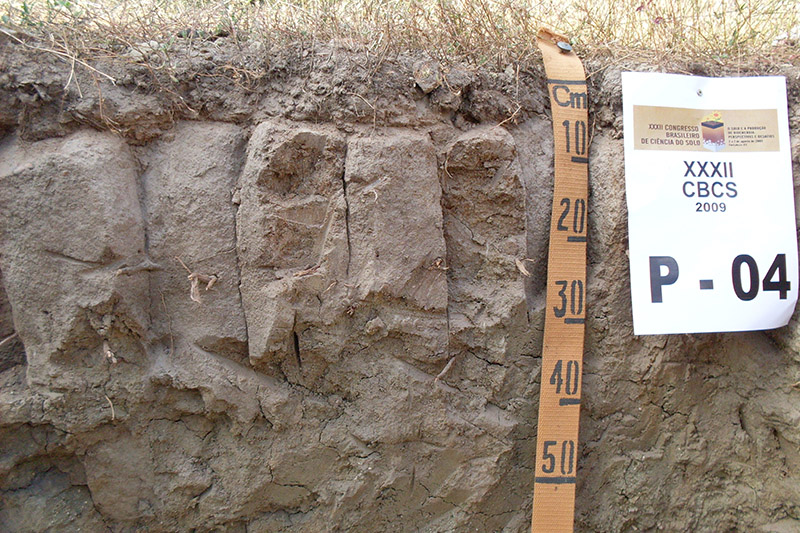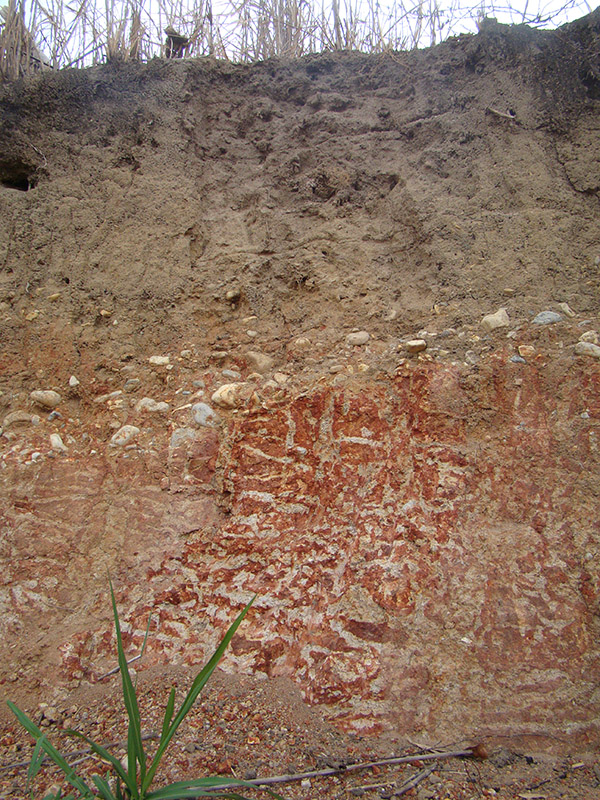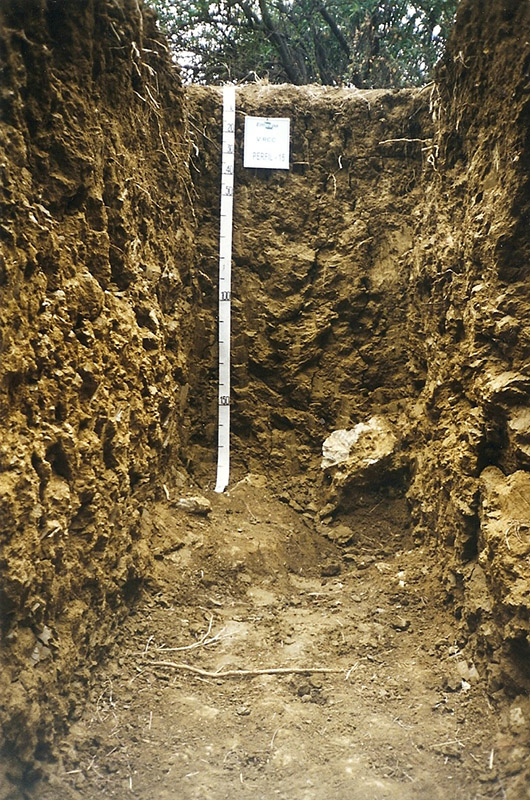Brazilian soils
 Soils in Brazil
Soils in Brazil
Brazil has a great diversity of soils across its continental extension, resulting from the wide diversity of soil environments and soil formation factors. In the 13 soil classes contained in the Brazilian Soil Classification System (SiBCS), the influence of these factors can be seen through the great variability of chemical, physical and morphological characteristics.
The broad peculiarities observed in pedoenvironments also represent an important condition for evaluating the potentials and limitations of each soil, conditioning its sustainability depending on the uses and management practices applied.
Oxisols, Argisols and Neosols predominate, which together are distributed across approximately 70% of the national territory. The Oxisols and Argisols classes occupy approximately 58% of the area and are deep, highly weathered, acidic soils with low natural fertility and, in certain cases, with high aluminum saturation. Soils of medium to high fertility also occur, generally shallow due to their low degree of weathering. These fall mainly into the classes of Neossolos, Luvisols, Planosols, Nitossolos, Chernossolos and Cambisols.
Brazilian Soil Classification System (SiBCS)
SiBCS is a hierarchical, multicategorical and open soil taxonomic system, with the purpose of classifying all existing soils in Brazil. Its key is made up of 6 categorical levels of classification: Order, Suborder, Large Group, Subgroup, Family and Series. Released as a book in 1997, SiBCS is the main reference on Brazilian soil classification. This year, the work reaches its 5th edition and is available for free for the first time, in e-book format. Click to download.
Download the Brazilian Soil Classes poster
Access the soil map and discover the characteristics of each of the soil classes present in Brazil by browsing the items below
This map represents the geographic distribution of soils in Brazil, according to the Brazilian Soil Classification System. Published in 2011. Scale: 1:5,000,000
Access the publication 'New Soil Map of Brazil: updated legend''
 Classification
Classification
Argisols
Soils with clay accumulation in the subsurface
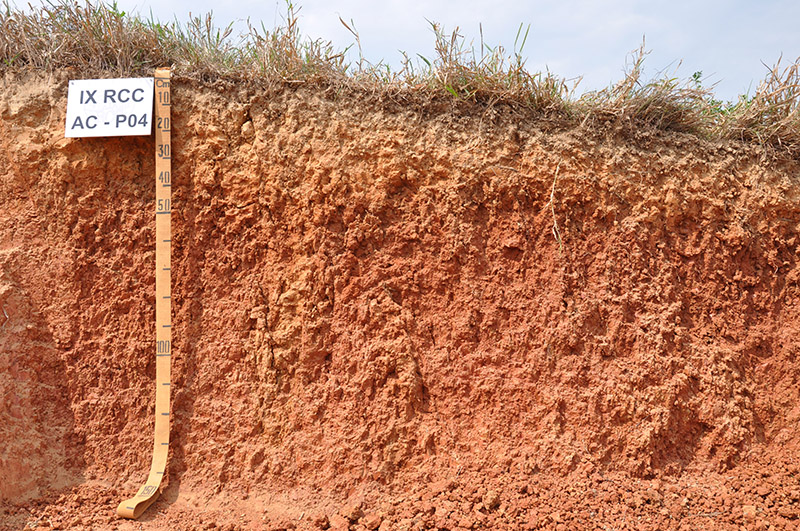
Photo: Sebastião Barreiros Calderano. Cruzeiro do Sul-AC.
Clay-sandy sediments of the Lower Solimões Formation
Identified by the higher clay content in the subsurface horizons compared to the surface ones, which characterizes a textural gradient along the profile. The color can vary from grayish to reddish, with yellow and red hues being the most common.
The predominant minerals are low activity clays (kaolinite) and/or oxides, which contribute to a cation exchange capacity value of less than 27 cmolc kg-1, and it is also possible to present an alilytic character.
Where are they present in Brazil?
This type of soil can be found in practically all Brazilian regions in different climate and relief conditions. They represent approximately 24% of the country's surface. In terms of geographic extension, they occupy the second position, after Oxisols.
Technical summary:
Soils made up of mineral material, with a textural B horizon immediately below A or E, with low activity clay or with high activity clay combined with low base saturation and/or alitic character in most of the B horizon, and still satisfying , the following requirements:
a) Plinth horizon, if present, does not meet the criteria for Plinthosol;
b) Glei horizon, if present, does not meet the criteria for Gleisol.
Symbol: P
Cambisols
Moderately developed soils
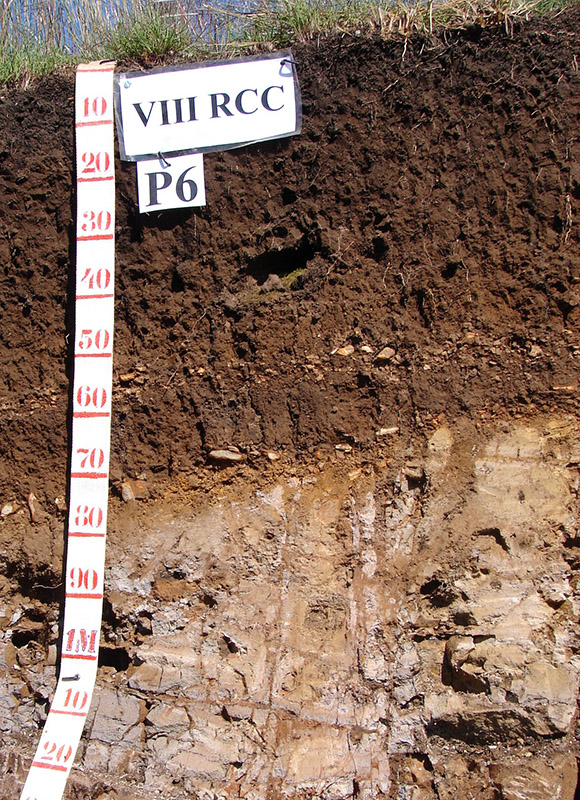
Photo: Marcos Gervásio Pereira. Água Doce-SC.
Decomposition products of rhyodacites
They comprise soils with incipient development, characterized by little differentiation of horizons in terms of morphological characteristics, mainly by color and structure.
The great variability in the nature and transformation of the source material provides wide variation in its chemical and granulometric composition.
Where are they present in Brazil?
They are distributed throughout the national territory, occupying around 2.5% of the country's area. They are particularly important in the eastern part of the plateaus of Rio Grande do Sul, Santa Catarina and Paraná, due to their high levels of organic matter and extractable aluminum content. Cambisols with high natural fertility are common in the northeastern region and in the State of Acre. Significant areas of Cambisols also occur in the Southeast region, developed from acidic rocks and in the Central-West region, from sandstones and quartzites.
Technical summary:
Soils consisting of mineral material with an incipient B horizon underlying any type of superficial horizon (except hystic with a thickness of 40 cm or more) or a chernozemic A horizon, when the incipient B has high activity clay and high base saturation. Plinthite and petroplinthite, glei horizon and vertic horizon, if present, do not satisfy the requirements for Plintisols, Gleisols and Vertisols, respectively.
Symbol: C
Chernosols
Soils with dark color on the surface and high base saturation
Photo: Ademir Fontana. Muqui-ES.
Clayey sediments
Characterized by the presence of a relatively thick, dark surface horizon, with good aggregation and the presence of 2:1 clay minerals.
Very fertile, they have medium to high carbon content and high calcium and magnesium content, providing high base saturation. They may present a high content of secondary calcium carbonate in the form of nodules.
Where are they present in Brazil?
These soils have a low occurrence in the South and Northeast of Brazil and in small areas in the Center-West, totaling approximately 0.5% of the national territory.
Technical summary:
Soils made up of mineral material, which have a chernozemic A horizon followed by:
a) Incipient B or textural B horizon, in all cases with high activity clay and high base saturation (excluding Vertisol); or
b) Calcium, petrocalcium or carbonate horizon coinciding with the chernozemic A horizon and/or C horizon, admitting, between the two, a Bi horizon with a thickness < 10 cm; or
c) Lithic contact as long as the chernozemic A horizon contains 150 g kg-1 of soil or more of equivalent calcium carbonate.
Symbol: M
Spodosols
Soils with accumulation of organic matter and/or aluminum and iron in the subsurface
Fotos: Maria de Lourdes Mendonça Santos. Quissamã-RJ.
Sedimentos arenosos marinhos do Quaternário
They have a subsurface horizon with an accumulation of organic matter and aluminum, and may or may not present an accumulation of iron. In general, the particle size composition has a predominance of the sand fraction. These are very poor and acidic soils.
The subsurface horizon (spodic B) can be dark, grayish and often yellowish and reddish in color, generally being overlapped by an eluvial, light-colored horizon (E horizon).
Where are they present in Brazil?
They are distributed very sparsely in the restinga areas and along the entire Brazilian coast, as well as in the interior areas of the Western Amazon, where they are quite significant. Its occurrence is estimated in approximately 2% of the national territory.
Technical summary:
These are soils made up of mineral material, with a spodic B horizon immediately below the E, A, or histic horizon, within 200 cm of the soil surface or 400 cm if the sum of the A+E horizons or the histic horizons (with less 40 cm) + And exceed 200 cm in depth.
Symbol: E
Gleisols
Soils with expression of reductomorphic features
Foto: Humberto Gonçalves dos Santos. Cassimiro de Abreu-RJ.
Quaternary clayey and organic sediments
Predominantly clayey and very clayey material that has undergone oxidation and reduction processes in a water-saturated environment, poorly or very poorly drained (hydromorphic). They are generally associated with recent sedimentary material in the vicinity of watercourses.
They are characterized by a low degree of pedogenetic development under hydromorphic conditions. They present great variability in terms of their chemical and physical composition due to the nature of the material deposited in a floodplain or depression environment.
The predominant colors in the subsurface are grayish or variegated, due to the processes of oxidation and reduction of iron, and may present mottled or plinthite due to the segregation of iron.
Where are they present in Brazil?
They are found in areas that have drainage restrictions, such as close to watercourses, floodplains and lowlands. They are present in the Amazon plain, in the states of Goiás, Tocantins, Rio de Janeiro and São Paulo and on the banks of the Patos, Mirim and Mangueira lagoons in Rio Grande do Sul, occupying around 4% of Brazil's area.
Technical summary:
Gleisols are soils made up of mineral material with a glei horizon beginning within the first 150 cm of the soil surface or at depths between 50 cm and 150 cm as long as it is immediately below the A or E horizon, or a histic horizon with insufficient thickness to define the class of Organosols. They do not have a vertic horizon or planic B horizon above or coincident with the glei horizon, nor any other type of diagnostic B horizon above the glei horizon or exclusively sandy or loamy sand texture in all horizons up to a depth of 150 cm from the soil surface or even a lytic contact. Plinth horizon, if present, must be at a depth greater than 200 cm from the soil surface.
Symbol: G
Oxisols
Highly developed soils
Foto: Maria de Lourdes Mendonça Santos. Grão-Mogol-MG.
Covering clayey sediments
They are highly weathered and without clay increment at depth. The colors vary from tanned, reddish or yellowish, the latter being more expressive. The texture varies from medium to very clayey and, in the most oxidized, there may be a granular structure, very small to small in size and with a degree of development that varies from strong to very strong.
The predominant minerals in the clay fraction are kaolinite and iron and aluminum oxides, which provide cation exchange capacity values lower than or equal to 17 cmolc kg-1.
Where are they present in Brazil?
They are typical of equatorial and tropical regions, on ancient erosion surfaces, sediments and ancient river terraces, normally in gently undulating and flat relief. They are the most representative soils in Brazil, occupying approximately 39% of the country's total area and distributed practically throughout the national territory.
Technical summary:
They are soils made up of mineral material, with an latosolic B horizon preceded by any type of A horizon within 200 cm of the soil surface or within 300 cm if the A horizon is more than 150 cm thick.
Symbol: L
Luvisolos
Soils with clay accumulation in the subsurface associated with high activity clay
Foto: José Francisco Lumbreras. Juazeiro-BA.
Saprolite of mica schists and gneisses
It has a well-developed structure and high natural chemical fertility. Identified by the significant increase in clay content in the subsurface horizons, they present, in many cases, an abrupt textural change. In general, they are shallow, reddish or yellowish in color, with a well-developed structure like blocks or prisms in the subsurface.
The high cation exchange capacity (greater than or equal to 27 cmolc kg-1) is due to the presence of 2:1 clay minerals, with high base saturation due to the high levels of calcium and magnesium.
Where are they present in Brazil?
Significant areas are found in northeastern Brazil, where they are mainly distributed in the semi-arid zone. The area of occurrence in Brazilian territory is estimated at 3%.
Technical summary:
These are soils made up of mineral material, presenting a textural B horizon with high activity clay and high base saturation in most of the first 100 cm of the B horizon (including BA), immediately below any type of A horizon (except chernozemic A) or under horizon E, and satisfying the following requirement: Plintic, vertic and planic horizons, if present, do not satisfy the criteria for Plintisols, Vertisols and Planosols, respectively, that is, they are not coincident with the superficial part of the textural B horizon.
Symbol: T
Neosols
Undeveloped soils
Foto: Maria de Lourdes Mendonça Santos. Lagoa Formosa-MG.
Decomposition products of Tufitos
These are soils that are little pedogenetically evolved and lack subsurface diagnostic horizons, either due to the reduced performance of pedogenetic processes or the action of formation factors. They are young, made up of mineral material or organic material less than 20 cm thick. They present a predominance of characteristics inherited from the original material, which confers great variability between suborders.
Neossolos are subdivided into lower classification levels into Litholic Neossolos (surface horizon directly over sound or semi-decomposed rock, or C or Cr horizon); Regolithic (soils with surface material based on rock or C or Cr horizon at a depth of more than 50 cm, with the occurrence of primary minerals); Fluvic (derived from alluvial sediments) and Quartzarenic (sandy soils, with a sandy or sandy texture).
Where are they present in Brazil?
They occur in approximately 15% of the Brazilian territory.
Technical summary:
Neosols are poorly evolved soils made up of mineral material or organic material less than 20 cm thick, without any type of diagnostic B horizon. Glei, plintic, vertic and chernozemic A horizons, when present, do not occur in diagnostic condition for the classes Gleisols, Plintisols, Vertisols and Chernosols, respectively.
Symbol: R
Nitisols
Clay soils, absence of textural gradient and well structured
Foto: Humberto Gonçalves dos Santos. Painel-SC.
Decomposition products of basalt from the São Bento group
They have a clayey or very clayey texture, with little increase in clay in depth and with a block or prism structure. Generally deep, with color varying from red to brunette, with little color differentiation observed between the horizons (absence of polychromy).
They are normally deep, well drained, structured, moderately acidic and have very variable natural fertility.
The surface of the aggregates in the subsurface horizons presents clay films, which is called waxy. Due to the high clay content, during the dry period they can contract and form cracks predominantly in the vertical direction.
Where are Brazil present?
The largest contiguous areas are in the southern states. However, in the State of São Paulo, extensive areas are found in the basaltic plateaus that extend to Rio Grande do Sul. The area of occurrence in Brazil is approximately 1.5%.
Technical summary:
Nitisols are soils made up of mineral material, with 350 g kg-1 or more of clay, including in the A horizon, which have a nitic B horizon below the A horizon. B horizon within 150 cm of the soil surface.
Polychromy (color variation in depth in the soil profile), as described below, must be used as an additional criterion in the distinction between Nitisols and Red or Red-Yellow Argisols in situations where the other characteristics coincide.
Nitisols practically do not present marked polychromy in the profile and must meet the following color criteria:
a) For soils with all the colors of horizons A and B, except BC, within the same hue page, variations of a maximum of 2 units for value and/or 3 units for chroma are allowed*;
b) For soils presenting colors from horizons A and B, except BC, in two hue pages, a variation of ≤ 1 value unit and ≤ 2 chroma units is allowed*;
c) For soils presenting colors from horizons A and B, except BC, in more than two hue pages, no variation in value is permitted and variation of ≤ 1 chroma unit is permitted*.
A chroma variation of one unit more than that indicated for intermediate soils (latosolic, rubric, etc.) is permitted, or when the difference occurs between the most superficial A horizon and the horizon(s) at the bottom of the profile, located ) more than 100 cm from the ground surface.
Symbol: N
Organosols
Organic soils
Foto: Ademir Fontana. Indianápolis-MG.
Organic deposits
Formed by high levels of organic matter, arising from the deposition and accumulation of plant residues, with or without a mixture of mineral materials. The accumulation of organic material can occur in free-draining conditions, at high altitudes and low temperatures, or with strong drainage restrictions, such as in lowlands or depressions.
It has high carbon content and a black, very dark gray or burnished color, resulting from the accumulation of plant remains.
Organic material can present different stages of decomposition (fibric, hemic and sapric), giving wide variation in chemical and physical attributes.
Where are they present in Brazil?
They occur in a very dispersed manner, in small patches, not constituting representative areas on small scales.
Technical summary:
Organosols are soils made up of organic material (organic carbon content greater than or equal to 80 g kg-1 of TFSA), which have a histic horizon, satisfying the following criteria:
a) 60 cm or more in thickness if 75% (expressed by volume) or more of the organic material consists of plant tissue in the form of remains of fine branches, fine roots, tree bark, etc., excluding living parts; or
b) Saturation with water for a maximum of 30 consecutive days per year, during the rainiest period, with a hystic O horizon, presenting the following thicknesses:
20 cm or more, when overlying a lithic contact or fragmentary material consisting of 90% or more (by volume) of rock fragments (gravel, pebbles and boulders); or
40 cm or more when overlying horizons A, B or C; or
c) Saturation with water during most of the year, in most years, unless artificially drained, presenting a hystic H horizon with the following thickness:
40 cm or more, whether extending in a single section from the surface of the ground or taken cumulatively within the surface 80 cm.
Symbol: O
Planosols
Soils with abrupt accumulation of clay in the subsurface and low permeability
Foto: José Coelho de Araújo Filho-CE. Quixadá-CE.
Products of the decomposition of gneiss and granites
They have a predominantly sandy texture on the surface, with a large increase in clay in the subsurface and an abrupt textural change or abrupt transition with a textural gradient. They are dense in the subsurface and extremely hard when dry and often have a prismatic or columnar structure in the subsurface.
The low permeability in the subsurface conditions iron reduction and oxidation cycles, resulting in grayish or variegated and mottled colors. In general, an eluvial and light-colored horizon is observed overlapping the subsurface horizon.
Where are they present in Brazil?
These soils occur predominantly in areas with flat or gently undulating relief, widely used for irrigated rice in Rio Grande do Sul and for pasture in the Northeast region of the country and in the Pantanal. They occupy approximately 2% of the country's area.
Technical summary:
These are soils made up of mineral material with an A or E horizon followed by a planic B horizon. Planic horizon without sodic character loses taxonomic precedence to the plinthic horizon. In short, they are soils made up of mineral material with an A or E horizon followed by a heavier B horizon, hydromorphic or not.
Symbol: S
Plinthosols
Soils with significant iron accumulation and segregation
Foto: Manoel Batista de Oliveira Neto. Goiana-PE.
Clay-sandy sediments of the Barreiras Formation
Characterized by imperfect drainage and cycles of iron reduction and oxidation, leading to iron segregation and the formation of plinthite (detachable feature of the soil matrix). Plinthite is a soft material, which when subjected to wetting and drying cycles can irreversibly consolidate to form petroplinthite (concretion).
The colors are predominantly gray, red and yellowish in a variegated or mottled pattern and often with a moderate increase in clay in the subsurface.
They are poor in organic carbon and rich in iron, or iron and aluminum, with quartz and other materials. They are often acidic and have a low nutrient reserve.
Where are they present in Brazil?
They are found in flat and gently undulating relief, in depressed areas, alluvial plains and lower thirds of slopes, situations that involve slow drainage of water from the soil. The largest extensions are found in the Amazon region (upper Amazon in Brazilian territory), Amapá, Ilha de Marajó, Baixada Maranhense, northern Piauí, Southeast Tocantins and Northeast Goiás, Pantanal Mato-Grossense and lowlands in the region of Ilha do Bananal and on the edges of plateaus in the Central Plateau. They occupy approximately 6% of the national territory.
Technical summary:
Plinthosols are soils made up of mineral material, with a plinthian or lithoplintic or concretionary horizon, in one of the following conditions:
Starting within 40 cm of the surface; or
b) Starting within 200 cm of the surface when preceded by the glei horizon or immediately below the A, E horizon or another horizon that presents pale, variegated colors or with abundant mottling.
When preceded by a horizon or layer of pale color (grayish, pale or light yellowish), they must have colors centered on the hues and chromas as per items (a) and (b) defined below, with or without mottled colors ranging from reddish until yellowed.
When preceded by horizons or layers of variegated color, at least one of the colors must satisfy the conditions of items (a) and (b) defined below.
When preceded by horizons or layers with a reddish or yellowish matrix, mottling must occur in abundant quantity (> 20% by volume) and present shades and chromas as per items (a) and (b) defined below.
a) Hue 5Y; or
b) Hues 7.5YR, 10YR or 2.5Y with chroma less than or equal to 4.
Symbol: F
Vertisols
Expansive soils with high base saturation
Foto: Sebastião Barreiros Calderano. Juazeiro-BA.
Limestone from the Caatinga Formation
Identified by the low degree of pedogenetic development and high clay content. They may contain 2:1 clay minerals, which provides high cation exchange capacity, expansion and contraction, with significant movement of the soil mass.
Wide and deep cracks and a wedge-shaped structure are commonly observed, formed in the dry period, as well as friction surfaces and micro relief on the surface called gilgai.
They are grayish or black in color, with no significant difference in clay content between the surface and subsurface parts of the soil. They have high chemical fertility, related to limestone and clayey sediments rich in calcium, magnesium and basic rocks, but present problems of a physical nature, such as low permeability, very heavy texture and slow drainage.
Where are they present in Brazil?
They occur predominantly in the dry zone of the Northeast, in the Pantanal of Mato Grosso, in the Campanha Gaúcha and in the Recôncavo Baiano, totaling around 2% of the area of Brazil.
Technical summary:
Vertisols are soils made up of mineral material with a vertical horizon between 25 and 100 cm deep and insufficient textural relationship to characterize a textural B. Furthermore, they must meet the following requirements:
a) Clay content, after mixing and homogenizing the soil material, in the surface 20 cm, of at least 300 g kg-1 of soil;
b) Vertical cracks in the dry period at least 1 cm wide, starting at the surface and reaching at least 50 cm deep, except in the case of shallow soils, where the minimum limit is 30 cm deep;
c) Absence of material with lithic contact, petrocalcium horizon or duripan within the first 30 cm of depth;
d) In irrigated or poorly drained areas (without apparent cracks), the coefficient of linear expansion (COLE) must be equal to or greater than 0.06 or the linear expandability is 6 cm or more; It is
e) Absence of any type of diagnostic B horizon above the vertic horizon.
Symbol: V
